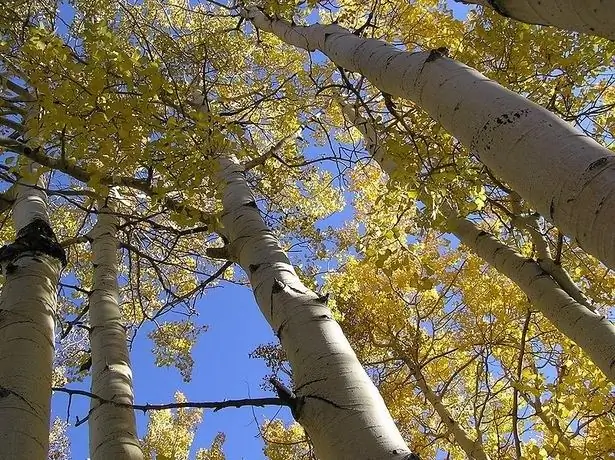It is impossible not to appreciate a smooth aspen trunk without a single knot, both from an aesthetic point of view and for the possibility of using it in the sawmill industry. Aspen also compares favorably with neighboring trees with its height. And for the endless fluttering of its leaves, which do not even need wind for this, the aspen received another name - the quivering poplar.

You can see what an aspen looks like in almost any region of Russia, because its distribution area is wide enough: from the southern steppes to the Arctic Circle. For many, the aspen tree is associated with such a magical effect as driving in an aspen stake and nothing more, but meanwhile it can appear to a person's gaze from a completely different side.
Types of aspens and their features
Aspen or poplar trembling belongs to the willow family, a genus of poplar. It is a tall tree with slender columnar trunks of gray-green color. The younger the aspen, the more greenish it is. Growing in one place for more than a century, aspen can reach a height of 30-35 meters and put main roots underground within a radius of 30 meters or more. There are few aspen varieties: common aspen and triploid aspen. Breeders have worked on the latter, although in appearance these species are no different from each other.
Like birch, in early spring, aspen presents the world with charming earring inflorescences. Since the tree is dioecious, male and female earrings differ in color: male ones are bright purple, and female ones are light green. Deciduous tree is beautiful at any time of the year. In summer, even in the most windless weather, its carved leaves are in constant motion. In autumn, they play with bright colors from bright yellow to purple-brown. Even in the rain, the smooth aspen trunk stands out with a pure green sheen.
An unpretentious tree is not afraid of excess moisture, shade, or frost. Aspen perfectly coexists with other trees in mixed forests. Experts are confident that the aspen population will actively increase in the near future. The fact is that no special instructions are needed to grow this tree. "Stick a stick in the ground and it will sprout" - this is exactly about the aspen.
What does aspen wood look like: properties
If other trees are destined to die during forest fires, then the dormant roots of the aspen, "feeling" the liberated areas of the forest space after the cutting of damaged trunks, become more active and give numerous shoots. Aspen seeds are also capable of scattering for many kilometers, giving rise to life for new seedlings. They just need to touch the surface of the earth and after 2 years a full-fledged tree will appear in this place. Moreover, aspen grows very quickly. If for use in the sawmill industry, spruce and pine will grow for a whole century, then aspen will mature in 30 years.
Aspen wood is white, dense, but soft and pliable. Since ancient times, blanks for woodcarving, well logs, planks for the foundation of church domes have been made from it. Since aspen wood feels good in a humid environment and does not rot for a long time, boats were made from it. The only drawback is the fact that aspen is prone to rotting inside the trunk. Usually this is typical for old trees, but they are able to transmit the tendency to this disease to their offspring. Therefore, scientists set out to obtain healthy trees by crossing common aspen with other species of the poplar genus.
In the modern sawmill industry, the rounded trunk of triploid aspen is successfully used for the manufacture of furniture. If outwardly this species in the forest cannot be distinguished from ordinary aspen, then they cannot be confused by the quality of the wood.







